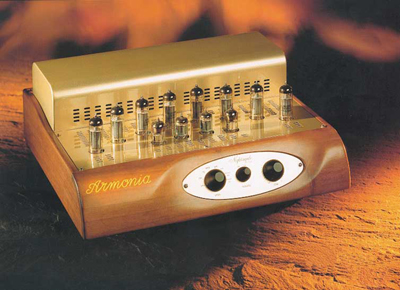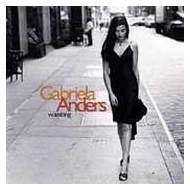You are reading the older HTML site
Positive Feedback ISSUE 9
october/november 2003
nightingale
Armonia integrated
as reviewed by Fransico Duran and Larry Cox

FRANCISCO DURAN'S SYSTEM: LOUDSPEAKERS ELECTRONICS SOURCE CABLES ACCESSORIES
|
 Watching the movie The Red Violin
the other night, I was reminded of the Nightingale Armonia amplifier. The Red Violin
exuded musicality and charmed its owners through the ages. The Armonia, with its walnut
cabinet and champagne top panel, also has the look and feel of an Old World instrument,
yet its designers have implemented features that make it competitive with today's high
quality competition.
Watching the movie The Red Violin
the other night, I was reminded of the Nightingale Armonia amplifier. The Red Violin
exuded musicality and charmed its owners through the ages. The Armonia, with its walnut
cabinet and champagne top panel, also has the look and feel of an Old World instrument,
yet its designers have implemented features that make it competitive with today's high
quality competition.
The Armonia is a 20-watt-per-channel integrated amplifier that operates in class A. It has automatic adjustment of bias current to within 0.5% and a standby function that keeps the tube filaments heated when the amp is turned off—features that will be welcomed by most tube amp lovers. It is equipped with four inputs plus an MM and MC phono stage and a tape loop. The tube complement consists of eight EL84s, two E88CCs for the preamp, and two E82CC phase inverters. The build quality and fit and finish are topnotch, and the metal work and walnut chassis make it quite beautiful to behold.
With all of those tubes, I expected the Armonia to sound on the warm side. It does, a little, but don't get the wrong idea. Harmonics sound full and natural, not thin or bleached out. The 20 watts under its hood are very fast and dynamic, yet the Armonia brings across the body and weight of an instrument. On my Deutsche Grammophon CD of Beethoven's Fifth and Sixth Symphonies, I was treated to a conductor (Herbert Von Karajan) that didn't spare the whip. Although transients were slightly less hard-hitting and punchy than with my Canary Audio combo, the dynamics were very satisfying, and the music moved along very well. The low end was full and strong, with the texture, tone, and timbre of the bass fiddles brought out in all their natural glory. I also heard very good reproduction of electric bass on pop music CDs, from Otis Rush to Government Mule. The electric and acoustic basses that are played together on several tracks on Orlando "Cachaito" Lopez' new CD were easily recognized.
CDs by Sara McLachlan and Sade always seem to be in my player. These discs are generally well recorded, but they do sound like CDs. The Armonia smoothed over some nasty digital peaks here and there, yet managed not to mask small details. Willie Nelson's voice on a few of his discs sounded smoother and less bright than with my amps. Just a smidgen of gravel was gone, but the character of his voice came through. The sheen of cymbals took on a more rounded, smoother, and slightly less sharp character, and I noticed a tad less air and sparkle. The midrange was a bit closed in, but then, my Antique Sound and Canary amps and my Canary preamp are a little bit bright.
 The Armonia produced a satisfying recreation of space and dimension, although not
as spacious as my Canary combo. With my amps, I can hear more clearly into the music, on a
more open stage. The Armonia's inner detailing was very good, though, and I could close my
eyes and get drawn into the music. The Armonia paid musical dividends on Gabriela Anders'
CD, Wanting. This beautiful Brazilian singer exudes charm in every note she
sings. Her subtle and sultry voice whispered romantic lyrics in my ear throughout this
disc. Yeah! Details were not razor sharp (thank God) nor did the amp resolve the very last
recesses of the soundstage. Then again, it was easy to get caught up in the music and
forget such things.
The Armonia produced a satisfying recreation of space and dimension, although not
as spacious as my Canary combo. With my amps, I can hear more clearly into the music, on a
more open stage. The Armonia's inner detailing was very good, though, and I could close my
eyes and get drawn into the music. The Armonia paid musical dividends on Gabriela Anders'
CD, Wanting. This beautiful Brazilian singer exudes charm in every note she
sings. Her subtle and sultry voice whispered romantic lyrics in my ear throughout this
disc. Yeah! Details were not razor sharp (thank God) nor did the amp resolve the very last
recesses of the soundstage. Then again, it was easy to get caught up in the music and
forget such things.
The Armonia drove my new Spendor 2/3s (88 dB) and the Zu Druid speakers (101 dB) with ease, but I wouldn't push it. The amp ran fairly quietly, and was trouble free, with the exception of a turn-on thump that had me slightly concerned each time I turned it on. The real strength of the Armonia is its musicality. This amp has a sweet, smooth, and clean way of handling the music that passes through it. It has that quality that is elusive in so many audiophile components—the ability to draw you in to the music. Some amps may have better resolution, but don't bring the music across in a natural manner. Some have wider soundstages, but aren't as involving. The Nightingale Armonia has gorgeous looks, loads of features, and delivers the musical goods! Francisco Duran
LARRY COX'S SYSTEM LOUDSPEAKERS ELECTRONICS SOURCE CABLES ACCESSORIES
|
 There are many things that could be
said about the Nightingale Armonia integrated amplifier—the numbers, the features,
stuff like that—and we'll get to that in a minute, but first the looks. The Armonia
is an Italian design, and Italians love, even worship beauty. When I was in Italy with my
wife a month ago, I was astounded at how many beautiful women were on the streets. (There
were also handsome men—beauty is something you can appreciate, even if you don't
desire it for yourself.) I'm not sure that Italians are more attractive than the rest of
us, but they do appreciate excellent, well-tailored clothing. Without necessarily being
dressed up, their clothing accentuated form and figure to a striking degree. What, you are
asking, does that have to do with an amplifier?
There are many things that could be
said about the Nightingale Armonia integrated amplifier—the numbers, the features,
stuff like that—and we'll get to that in a minute, but first the looks. The Armonia
is an Italian design, and Italians love, even worship beauty. When I was in Italy with my
wife a month ago, I was astounded at how many beautiful women were on the streets. (There
were also handsome men—beauty is something you can appreciate, even if you don't
desire it for yourself.) I'm not sure that Italians are more attractive than the rest of
us, but they do appreciate excellent, well-tailored clothing. Without necessarily being
dressed up, their clothing accentuated form and figure to a striking degree. What, you are
asking, does that have to do with an amplifier?
The Nightingale Armonia isn't your typical amplifier in a metal box.
There is metal on the undercarriage, on the top where the tubes stick out, and along the back of the amplifier where the four line level inputs, the MM and MC phono inputs and 4- and 8-ohm taps are located, but the rest of this puppy is solid walnut. The reason that I tell you about the Armonias' cosmetics first is that the looks could send you running to "proper" looking stuff. You might even think that the conventional stuff sounds better. Don't. Whether or not the Armonia is your cup of tea is more likely related to system matching, room size, speaker efficiency etc., but the wood look grows on you. After living with the Armonia for about three months, I came to feel that it was the proper way for an amplifier to look.
As to system matching, here are the vitals on the Armonia. It a 20-watt-per-channel integrated tube amplifier operating in pure class A over the whole range of both power and frequency. It employs four EL 84 tubes per channel in the output stage, 2 E88C tubes in the preamp, and 2 E82CC tubes as phase inverters. Bias is electronically set, so you don't need to get a voltmeter or screwdriver to keep things in tune. Nightingale claims a frequency response from 10 Hz to 40 kHz.
The Armonia had lots of bass, much to my surprise. I have no way of measuring bass response, but both the Taminos and the Cadence Divas had plenty of bass with the Armonia, more like the bass I expect of solid state than of tubes. Neither set of speakers has a particularly tight, speedy low end, and the Armonia easily fell into company with them. Do you want the ultimate in bass or something that reproduces bass in its many iterations? The Armonia gives you bass that gives an impression of strings vibrating on a standup bass and that suggests that there are real instruments working between your speakers. If you want rock-hard bass, look to Thiel or powered ATCs for speakers and Krell for amps, but not to the Divas, the Taminos, or the Armonia.
Speaking of real instruments working between your speakers, the Armonia images really well. I haven't converted to being a soundstage nut, but the Armonia gave an attractive solidity to sonic images that will certainly wow your non-audiophile friends. Although Nightingale claims 40 kHz extension, I wouldn't say that the Armonia's treble sounded any more extended than a number of other amplifiers I've heard, but here's the important point—tubes with good extension are becoming the norm. The Armonia doesn't call attention to its tube origins in either the bottom or the top end. It never sounded hard or etched unless the recording was that way, and its presentation was more than just livable. Vocals, both male and female, were warm and rich, with a noticeable golden glow. This euphony suited Emmylou Harris and the Indigo Girls' higher-pitched vocals better than, say, Mary Black's lower register. Likewise, Steve Forbert's wispy vocals were better treated than Andrea Bocelli's, but again, vocals were a delight to hear.
The Armonia delivers a whole range of features. It can accommodate nearly any form of cartridge, be it moving coil or moving magnet, plus four sources and a tape (or CD) recorder. The Armonia isn't the last word in transparency, but like the forms and figures of Italian clothing, there's a lot to like. I see this amplifier going into the house of someone who appreciates the beauty of both music and objects, someone whose life includes a love and appreciation of music but whose existence doesn't revolve around it. Is that someone you? Give a listen. You might find the Armonia well tailored to your life. Larry Cox
Armonia
integrated
Retail: $3695
Nightingale
web address: www.nightingale.it
OS Services
web address: www.ossaudio.com
email address: [email protected]
